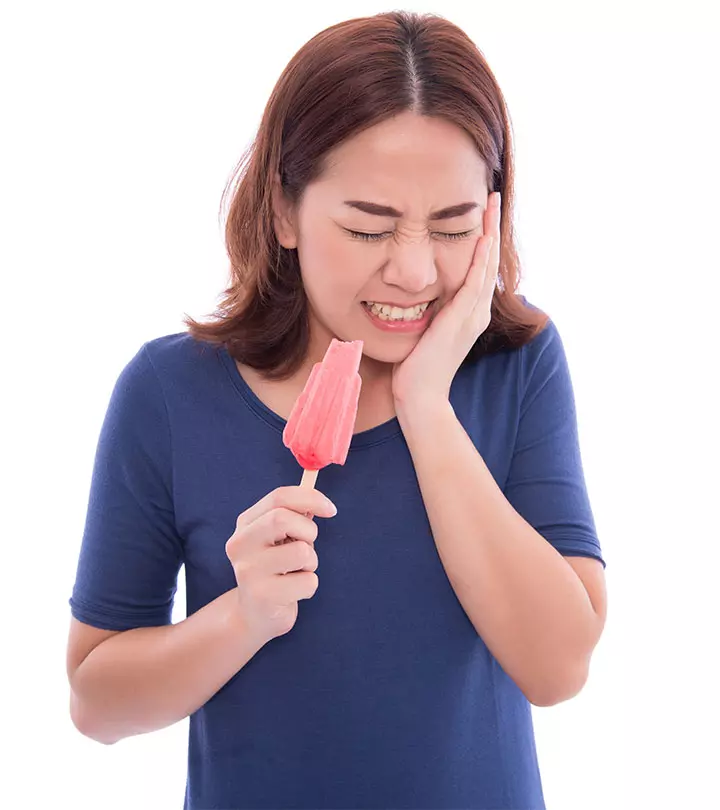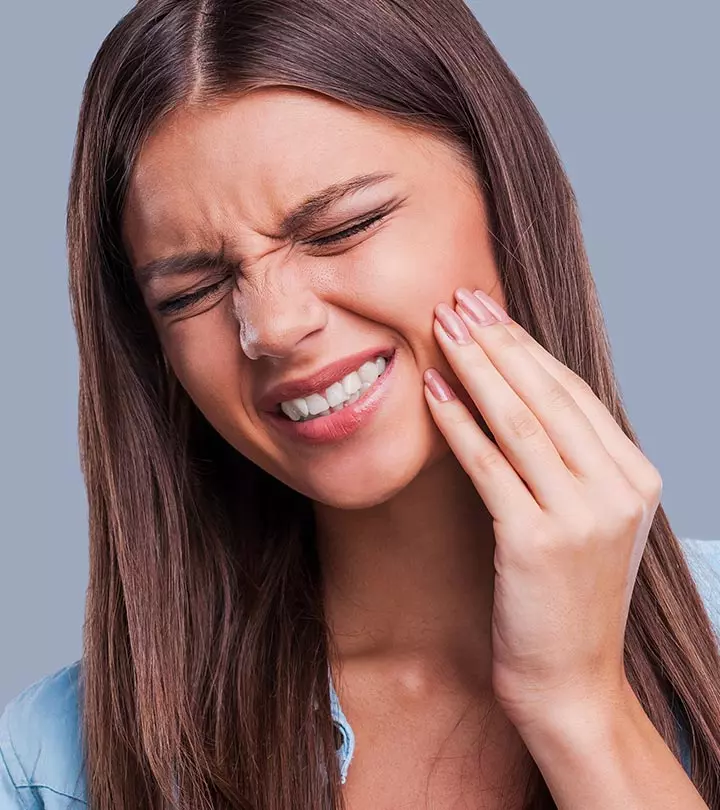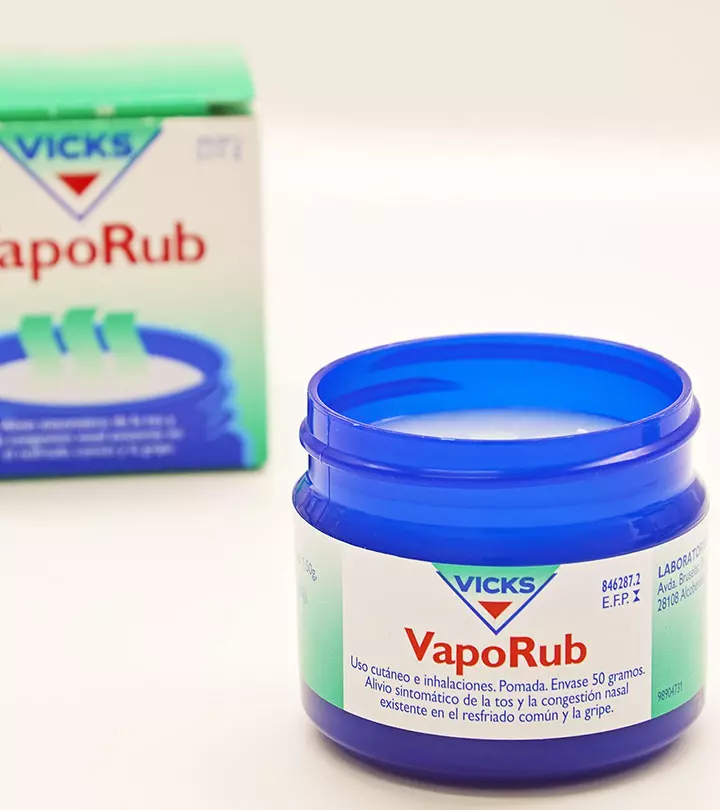10 Home Remedies For Tooth Sensitivity That Ease Pain
Dealing with tooth sensitivity and pain is easy through a few simple natural ways.

Image: Shutterstock
Tooth sensitivity is a highly prevalent and excruciatingly painful condition. According to a study published in the Journal of the American Dental Association, 12 percent of people in the northwest of the United States have sensitive teeth (1). Though medical therapy is almost always required, you may obtain some comfort using home remedies for tooth sensitivity while you wait for your dentist’s appointment.
When exposed to something hot, cold, or acidic, sensitive teeth are prone to pain. It can be helpful to know what to avoid if you have sensitive teeth to lower your risk of triggering the pain. In this post, we have compiled a list of such items along with some effective home remedies so you can get relief from tooth sensitivity.
- Home Remedies For Treating Tooth Sensitivity
- Prevention Tips
- Foods To Be Avoided With Sensitive Teeth
- What Causes Tooth Sensitivity?
- Symptoms Of Sensitive Teeth
Home Remedies For Treating Tooth Sensitivity
1. Coconut Oil Pulling
has a wide range of benefits for oral health (2). The analgesic and anti-inflammatory properties of the oil (especially virgin coconut oil) can help reduce tooth pain (3).
You Will Need
1 tablespoon of virgin coconut oil
What You Have To Do
- Swish a tablespoon of the coconut oil in your mouth for 15 to 20 minutes.
- Spit the oil out and brush your teeth.
How Often You Should Do This
Do this once daily, preferably every morning.
2. Salt Water Rinse
Salt has anti-inflammatory properties. Rat studies show that it may help reduce inflammation (4). Hence, a saltwater rinse could help alleviate tooth pain.
You Will Need
- ½ teaspoon of salt
- 1 glass of warm water
What You Have To Do
- Add half a teaspoon of salt to a glass of warm water.
- Mix well and use the solution to rinse your mouth.
How Often You Should Do This
Do this 2 times daily.
3. Yogurt
Yogurt helps reduce the demineralization of the tooth enamel (5). Though there is no research if this property could help treat tooth sensitivity, yogurt could promote oral health (6). It also is rich in calcium, an important component of teeth.
You Will Need
½ bowl of plain yogurt
What You Have To Do
Consume half a bowl of plain yogurt.
How Often You Should Do This
Do this once daily.
4. Guava Leaves
Mice studies show that guava leaves have anti-inflammatory properties (7). These may help in the treatment of tooth sensitivity.
You Will Need
A few guava leaves
What You Have To Do
- Wash the guava leaves thoroughly.
- Chew on them for 1 to 2 minutes and then spit out.
How Often You Should Do This
Do this 1 to 2 times daily.
5. Garlic
Garlic compounds exhibit anti-inflammatory and antimicrobial properties. They also help fight oral pathogens (8), (9). The anti-inflammatory properties of garlic could help ease the pain associated with tooth sensitivity.
You Will Need
- 1 garlic clove
- A few drops of water
- A pinch of salt
What You Have To Do
- Crush a clove of garlic.
- Add a few drops of water and a pinch of salt to it.
- Apply the mixture to the affected tooth.
- Leave it on for 10 to 15 minutes before washing it off with water.
How Often You Should Do This
Do this once daily.
6. Onion
Onions have anti-inflammatory and antibacterial properties that fight oral pathogens (10), (11). These properties may also play a role in reducing the pain associated with tooth sensitivity.
You Will Need
A small piece of onion
What You Have To Do
- Chew on a small piece of onion for a few minutes.
- Alternatively, you can place a piece of onion near the affected tooth and gums and leave it on for about 10 minutes.
How Often You Should Do This
Do this 1 to 2 times daily.
7. Essential Oils
a. Clove Oil
The analgesic effect of clove oil could help relieve toothache (12). The natural microbicide properties of clove oil can help in killing oral pathogens (13).
Note: Clove oil has a potent smell. Therefore, use it with a carrier oil.
You Will Need
- 6 drops of clove oil
- 1 teaspoon of coconut oil
What You Have To Do
- Add six drops of clove oil to a teaspoon of coconut oil.
- Mix well and apply the mixture to the affected tooth and gums.
- Leave it on for 5 to 10 minutes before rinsing your mouth with water.
How Often You Should Do This
Do this 1 to 2 times daily.
b. Tea Tree Oil
Tea tree oil has anti-inflammatory and antimicrobial properties (14). These may help alleviate some of the pain associated with tooth sensitivity.
Caution: Do not swallow the essential oil mixture.
You Will Need
- 6 drops of tea tree oil
- 1 teaspoon of coconut oil
What You Have To Do
- Add six drops of tea tree oil to a teaspoon of coconut oil.
- Apply this mixture to the affected tooth and gums.
- Leave it on for 5 to 10 minutes before washing it off.
How Often You Should Do This
Do this 1 to 2 times daily.
8. Vanilla Extract
Vanilla extract was found to have anti-nociceptive properties (reducing the perception of pain) (15). It may help reduce the pain associated with tooth sensitivity.
You Will Need
- 4 drops of vanilla extract
- Cotton pad
What You Have To Do
Dab the cotton pad with vanilla extract and apply it to the sensitive gums for 3-5 minutes.
How Often You Should Do This
You can do this multiple times a day.
9. Vitamins
If you have tooth sensitivity, ensure you are getting enough B vitamins. The deficiency of the B vitamins (B12, especially) was linked to dental caries in children (16). Though this may not be directly related to tooth sensitivity, taking adequate B vitamins could promote oral health.
Vitamin E may also help treat toothache, although research is lacking in this aspect. A study states that vitamin E could have anti-inflammatory effects on rats with ulcerative colitis (17). There is insufficient information to understand if these anti-inflammatory properties translate to treating tooth pain as well.
However, including foods rich in these vitamins can help. These include
almonds, spinach, kale, turnip, fish, poultry, meat, eggs, and dairy.
10. Fluoride Mouthwash
Fluoride mouthwashes and toothpaste are recommended for treating tooth sensitivity as they help strengthen your enamel and also reduce toothache to a large extent. The mouth rinses were also found to prevent dental caries in children and adolescents (18), (19).
You Will Need
1 small cup of fluoride mouthwash
What You Have To Do
- Rinse your mouth with a small cup of fluoride mouthwash.
- Swish it in your mouth for 1 to 2 minutes before spitting it out.
How Often You Should Do This
Do this 2 times daily.
While following the aforementioned remedies, it also is important to take precautions to prevent tooth sensitivity in the future. The upcoming section has some tips that you can follow.
Prevention Tips
- Use a soft-bristled toothbrush.
- Brush your teeth gently.
- Avoid grinding your teeth.
- Reduce acidic foods.
- Follow good oral hygiene.
- Visit your dentist regularly to keep track of your oral health.
What you eat largely determines your oral health. You may also want to avoid the following foods.
Foods To Avoid If You Have Sensitive Teeth
- Ice cream
- Soda
- Hot coffee/tea
- Candies
- Sticky toffee
- Citrus fruits
- Tomatoes
- Ice and cold drinks
Tooth sensitivity can easily be managed by following a proper oral regimen and eliminating certain foods from your diet. However, if you happen to develop severe and unbearable tooth pain, it is best to visit a dentist immediately.
Tooth sensitivity can have various causes. In the following section, we have discussed the most common ones. Being aware of the causes can help you prevent tooth sensitivity in the future.
What Causes Tooth Sensitivity?
Tooth sensitivity occurs when a material inside your tooth, called dentin, loses its protective covering (also called cementum).
This exposes the nerve endings of your tooth to hot, cold, and acidic foods, resulting in increased tooth sensitivity.
Some common factors that contribute to tooth sensitivity are:
- Damaged tooth enamel from using a hard toothbrush
- Eroded tooth due to consumption of highly acidic foods and beverages
- Tooth decay
- Worn-out teeth fillings
- Broken tooth
- Receding gums
- Teeth grinding (at night)
- A dental procedure
- Whitening treatment
The following are the symptoms of sensitive teeth.
Symptoms Of Sensitive Teeth
- Increased tooth sensitivity to hot, cold, and acidic foods
- Tooth pain while breathing in cold air
- Receding gums
- Redness or swelling of gums
The loss of the protective material around the dentin of a tooth causes the nerve endings within to be exposed and thus results in tooth sensitivity. This loss may be triggered by various factors such as damage from brushing too hard or teeth grinding, tooth decay or erosion, and receding gums, to name a few. You can identify tooth sensitivity from symptoms such as tooth pain when exposed to cold air and hot, acidic, or cold foods. While the home remedies for tooth sensitivity discussed here can bring relief from pain or sensitivity, they are not substitutes for medical treatment.
Frequently Asked Questions
Which is the best toothpaste for sensitive teeth and gums?
A fluoride-based toothpaste is your best bet to relieve tooth sensitivity and enhance your overall oral health. Look for a toothpaste that contains potassium nitrate, which soothes the nerve endings of your tooth. Certain toothpaste also contains stannous fluoride, which forms a protective layer on your eroded tooth, thereby relieving pain and sensitivity. Consult a dentist who will help you select the best toothpaste for your teeth.
Can a cavity heal on its own?
Cavities are holes that form in your teeth as a result of decay. They don’t heal on their own and need to be treated immediately as they put your gums and tooth at the risk of infection.
How do you know if you need a root canal?
Certain symptoms like pain while eating, a sensitivity that lingers long after the trigger (hot or cold) has been removed, or even a small bump near the area of tooth pain could mean you need a root canal.
References
Articles on StyleCraze are backed by verified information from peer-reviewed and academic research papers, reputed organizations, research institutions, and medical associations to ensure accuracy and relevance. Read our editorial policy to learn more.
- The prevalence of dentin hypersensitivity in general dental practices in the northwest United States, The Journal of the American Dental Association.
https://secure.jbs.elsevierhealth.com/action/getSharedSiteSession?redirect=https%3A%2F%2Fjada.ada.org%2Farticle%2FS0002-8177(14)60372-X%2Ffulltext&rc=0 - Shanbhag, Vagish Kumar L. “Oil pulling for maintaining oral hygiene – A review.” Journal of traditional and complementary medicine vol. 7,1 106-109.
https://www.ncbi.nlm.nih.gov/pmc/articles/PMC5198813/ - Intahphuak S, Khonsung P, Panthong A. Anti-inflammatory, analgesic, and antipyretic activities of virgin coconut oil. Pharm Biol. 2010;48(2):151–157.
https://pubmed.ncbi.nlm.nih.gov/20645831// - Theobaldo, Mariana Cardillo et al. “Hypertonic saline solution reduces the inflammatory response in endotoxemic rats.” Clinics (Sao Paulo, Brazil) vol. 67,12 (2012): 1463-8.
https://www.ncbi.nlm.nih.gov/pmc/articles/PMC3521811/ - Varghese L, Varughese JM, Varghese NO. Inhibitory effect of yogurt extract on dental enamel demineralisation – an in vitro study. Oral Health Prev Dent. 2013;11(4):369–374.
https://pubmed.ncbi.nlm.nih.gov/24046825// - Manaf, Zahara Abdul et al. “Relationship between food habits and tooth erosion occurrence in Malaysian University students.” The Malaysian journal of medical sciences : MJMS vol. 19,2 (2012): 56-66.
https://www.ncbi.nlm.nih.gov/pmc/articles/PMC3431744/ - Jang M, Jeong SW, Cho SK, et al. Anti-inflammatory effects of an ethanolic extract of guava (Psidium guajava L.) leaves in vitro and in vivo. J Med Food. 2014;17(6):678–685.
https://pubmed.ncbi.nlm.nih.gov/24738717/ - Bachrach G, Jamil A, Naor R, Tal G, Ludmer Z, Steinberg D. Garlic allicin as a potential agent for controlling oral pathogens. J Med Food. 2011;14(11):1338–1343.
https://pubmed.ncbi.nlm.nih.gov/21548800/ - Arreola, Rodrigo et al. “Immunomodulation and anti-inflammatory effects of garlic compounds.” Journal of immunology research vol. 2015 (2015): 401630.
https://www.ncbi.nlm.nih.gov/pmc/articles/PMC4417560/ - Dorsch W, Schneider E, Bayer T, Breu W, Wagner H. Anti-inflammatory effects of onions: inhibition of chemotaxis of human polymorphonuclear leukocytes by thiosulfinates and cepaenes. Int Arch Allergy Appl Immunol. 1990;92(1):39–42.
https://pubmed.ncbi.nlm.nih.gov/2246074// - Kim JH. Anti-bacterial action of onion (Allium cepa L.) extracts against oral pathogenic bacteria. J Nihon Univ Sch Dent. 1997;39(3):136–141.
https://pubmed.ncbi.nlm.nih.gov/9354029// - Kamkar Asl, Mina et al. “Analgesic effect of the aqueous and ethanolic extracts of clove.” Avicenna journal of phytomedicine vol. 3,2 (2013): 186-92.
https://www.ncbi.nlm.nih.gov/pmc/articles/PMC4075701/ - Nuñez, L, and M D’ Aquino. “Microbicide activity of clove essential oil (Eugenia caryophyllata).” Brazilian journal of microbiology : [publication of the Brazilian Society for Microbiology] vol. 43,4 (2012): 1255-60.
https://www.ncbi.nlm.nih.gov/pmc/articles/PMC3769004/ - Carson, C F et al. “Melaleuca alternifolia (Tea Tree) oil: a review of antimicrobial and other medicinal properties.” Clinical microbiology reviews vol. 19,1 (2006): 50-62.
https://www.ncbi.nlm.nih.gov/pmc/articles/PMC1360273/ - de Cássia da Silveira E Sá, Rita et al. “Analgesic-Like Activity of Essential Oil Constituents: An Update.” International journal of molecular sciences vol. 18,12 2392.
https://www.ncbi.nlm.nih.gov/pmc/articles/PMC5751100/ - M Hugar, Shivayogi et al. “Assessment of Vitamin B12 and Its Correlation with Dental Caries and Gingival Diseases in 10- to 14-year-old Children: A Cross-sectional Study.” International journal of clinical pediatric dentistry vol. 10,2 (2017): 142-146.
https://www.ncbi.nlm.nih.gov/pmc/articles/PMC5571382/ - Tahan, Gulgun et al. “Vitamin E has a dual effect of anti-inflammatory and antioxidant activities in acetic acid-induced ulcerative colitis in rats.” Canadian journal of surgery. Journal canadien de chirurgie vol. 54,5 (2011): 333-8.
https://www.ncbi.nlm.nih.gov/pmc/articles/PMC3195661/ - Petersson, Lars G. “The role of fluoride in the preventive management of dentin hypersensitivity and root caries.” Clinical oral investigations vol. 17 Suppl 1,Suppl 1 (2013): S63-71.
https://www.ncbi.nlm.nih.gov/pmc/articles/PMC3586140/ - Marinho, V C C et al. “Fluoride mouthrinses for preventing dental caries in children and adolescents.” The Cochrane database of systematic reviews, 3 (2003): CD002284.
www.ncbi.nlm.nih.gov/pubmed/12917928
Read full bio of Dr. Thomas Connelly
Read full bio of Shaheen Naser


























Community Experiences
Join the conversation and become a part of our empowering community! Share your stories, experiences, and insights to connect with other beauty, lifestyle, and health enthusiasts.